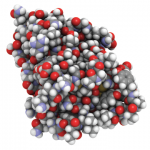Dr. Dorner attributed the discrepancy between the lack of ACR20 response and the sustained remission rates to the forced discontinuation at Week 12 and what may have been an inflated placebo response, because so many of the patients had very limited access to biologic therapy and a chance to receive open-label extension therapy after the actual study period.
“The results overall are indicative for a strong potential for disease-modifying activity of vobarilizumab, supporting treat-to-target management of RA,” Dr. Dorner said.
In the Crosshairs
In another study, the fully human immunocytokine, dekavil, demonstrated good initial safety and efficacy results in Phase 1b. Immunocytokines involve fusing an antibody and a cytokine—in this case, the vascular-targeting antibody F8 fused to IL10—for what is intended to be better targeting of disease, ideally sparing normal tissue.2
RA patients, who had not responded to at least one TNF inhibitor, were treated with one of 10 doses—6 µg/kg to 600 µg/kg—along with a fixed MTX dose, said Mauro Galeazzi, MD, professor of rheumatology at the University of Siena in Italy.
Just one of 35 patients had a dose-limiting toxicity or serious adverse event. That patient, in the 450 µg/kg group, experienced Grade 2 purpura and Grade 2 dyspnea, which was not deemed drug related, and fully recovered after one week of being treated with corticosteroids.
After eight weeks, improvement was seen in ACR or EULAR response criteria, or both, in 62.5% of the 24 patients able to be evaluated. Two patients, at 30 µg/kg and 60 µg/kg, had an ACR70 response for more than a year after their treatment ended, Dr. Galeazzi said.
The drug is now being studied in Phase 2, at 30 µg/kg and 160 µg/kg, with MTX.
“We have already included in the study 23 patients, and we are waiting for 45 patients to give you the interim analysis,” he said.
A third study examined a large Swedish database and found no significant increase for first solid or hematologic cancer risk among RA patients taking tocilizumab, abatacept, rituximab or a TNF inhibitor for the first time, compared with those taking conventional synthetic disease-modifying anti-rheumatic drugs (csDMARDs). There was also no increased risk for those on a second TNF inhibitor.3
The study, by researchers at Karolinska Institute in Stockholm, was an analysis of data from linked national and population Swedish registers and included more than 63,000 patients—1,693 tocilizumab patients, 1,894 abatacept patients, 3,119 rituximab patients, 10,300 on a first TNF inhibitor and 4,130 on a second TNF inhibitor, with 42,365 patients on csDMARDs as a reference group. Patients with previous malignancies were excluded, and researchers didn’t include non-melanoma skin cancers in their overall analysis. Researchers adjusted for age, sex, comorbidities, hospital stays, use of non-steroidal anti-inflammatory drugs and other factors.


